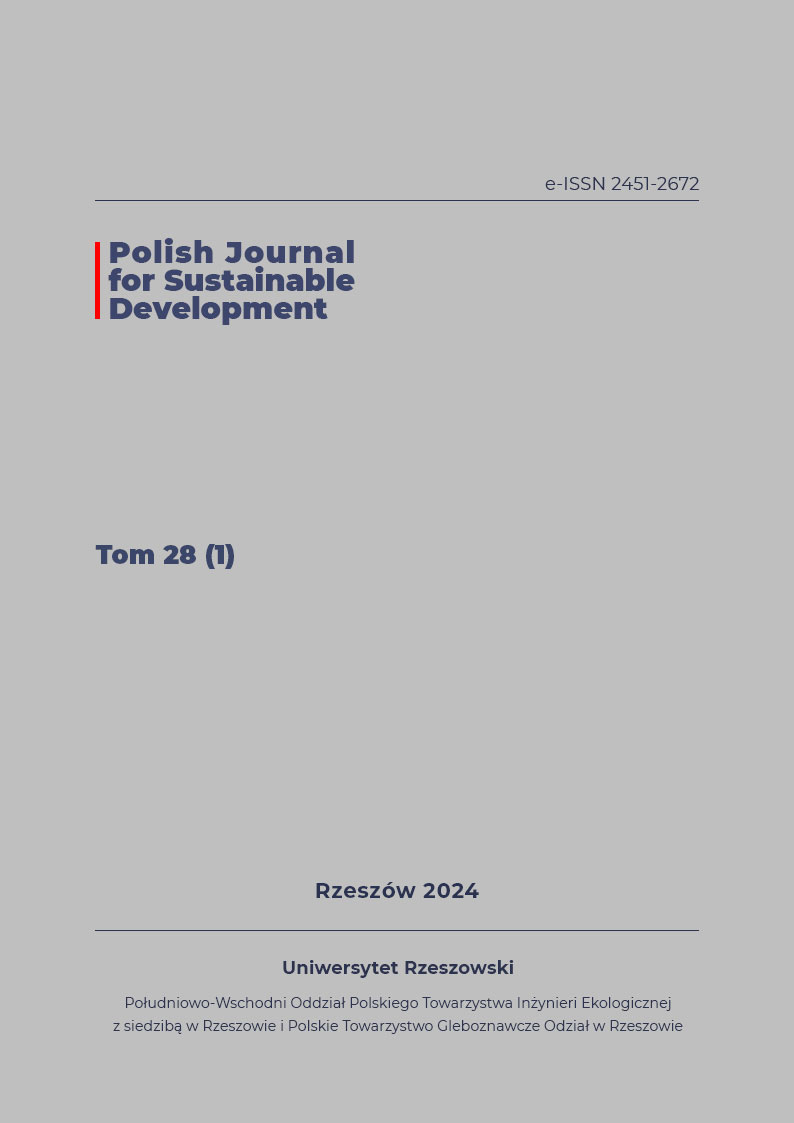Waste from the textile industry as a nitrogen carrier organic for the horticulture sector
DOI:
https://doi.org/10.15584/pjsd.2024.28.1.5Keywords:
textile industry, waste cotton, organic nitrogen, retardationAbstract
The fast fashion phenomenon generates significant amounts of textile waste every year. Only in Europe it is 12.6 million Mg, of which oak trees and footwear account for 5.2 million Mg. One way to manage them is material recycling, where new fabric will be created in the processes of fiberising, spinning and weaving, but the share of waste processed in this way is 1% of the mass. Another method is development aimed at improving the properties of soil by using physically and chemically modified waste and using it as a soil improver. The study examined the possibility of using waste cotton fabric as a carrier of an organic nitrogen fertilizer with a sustainable effect. Scraps of waste cotton fabric with a grammage of 408 g/m2 were saturated with hot collagen solution, which after drying constituted 1/3 of the weight of the samples. The scraps prepared in this way were used as fertilizer for light soil with a granulometric composition of clay sand. Rinsing with rainwater at a temperature of 20oC was used. The nitrogen contained in the collagen was released into the soil solution within 42 days, with the maximum concentration occurring 4-6 days after application. An additional advantage of the obtained material is the natural water capacity of cotton, which is important from the point of view of collecting water in light soils. At the same time, slow degradation of the cotton fabric was observed, which broke into fragments after 3 months of incubation. The applied modification of waste cotton fabric makes it possible to use textile waste as a fertilizer carrier, which will reduce the weight of cotton waste sent for incineration or landfilled.
Downloads
References
Abbas T., Nawab B., Nazli R., Saleem R., Lal A., Jamil K. 2013. Efficacy of cotton waste compost and fertinemakil fertilizer on the growth parameter of sunflower plants. Pakistan J. Agric. Res. Vol. 26(1). 54-58.
Chen H., Li Y., Dai H., Chen L., Ding X., Hu Z. 2023. Collagen hydrolyzed extract derived from leather waste as a multifunctional additive for the preparation of granular fertilizer. Sustainable Chemistry and Pharmacy 36. 101327. https://doi.org/10.1016/j.scp.2023.101327.
Ciesielczuk T., Rosik-Dulewska Cz., Szewczyk A., Poluszyńska J. 2016. Dynamika uwalniania azotu z nawozów o powolnym działaniu w eksperymencie laboratoryjnym. Rocznik Ochrona Środowiska. 18. 506-517.
Ciesielczuk T., Poluszyńska J., Szewczyk A., Rosik-Dulewska Cz., Sporek M. 2018. Dynamic of Components Leachate from Experimental Fertilizers in Leaching Test. Journal of Ecological Engineering. Vol. 19. https://doi.org/10.12911/22998993/82801.
Golcz A., Komosa A. 2006. Uwalnianie się azotu, fosforu i potasu z nawozu wolnodziałającego osmocote plus w uprawie papryki (Capsicum annuum L.). Acta Agrophysica. 7(3). 567-576.
Hossain Z. von Fragstein und Niemsdorff P., Heβ J. 2016. Plant Origin Wastes as Soil Conditioner and Organic Fertilizer: A Review. American-Eurasian J. Agric. & Environ. Sci. 16 (7). 1362-1371 DOI:10.5829/idosi.aejaes.2016.16.7.12961.
Maeda M., Zhao B., Ozaki Y., Yoneyama T. 2003. Nitrate leaching in an Andisol treated with different types of fertilizers. Environmental Pollution. 121. 477-487. https://doi.org/10.1016/S0269-7491(02)00233-6.
Maiti R. 2023. Fast Fashion: Its Detrimental Effect on the Environment [wwwDocument]. Earth.Org. URL https://earth.org/fast-fashions-detrimental-effect-on-the-environment/ (accessed 12.27.23).
Niinimäki K., Peters G., Dahlbo H., Perry P., Rissanen T., Gwilt A. 2020. The environmental price of fast fashion. Nat. Rev. Earth Environ. 1. 189-200. https://doi.org/10.1038/s43017-020-0039-9.
Patel H., Mangukiya H., Maiti P., Maiti S. 2021. Empty cotton boll crop-residue and plastic waste valorization to bio-oil, potassic fertilizer and activated carbon – A bio-refinery model. Journal of Cleaner Production. 290. 125738. https://doi.org/10.1016/j.jclepro.2020.125738.
Rukhaya S., Yadav S., Rose N.M., Grover A., Bisht D. 2021. Sustainable approach to counter the environmental impact of fast fashion. The Pharma Innovation Journal SP. 10(8). 517-523.
Singh R.P., Kumar S., Sainger M., Sainger P.A., Barnawal D. 2017. Eco-friendly Nitrogen Fertilizers for Sustainable Agriculture. In: Rakshit A., Abhilash P., Singh H., Ghosh S. (eds). Adaptive Soil Management: From Theory to Practices. Springer, Singapore. https://doi.org/10.1007/978-981-10-3638-5_11.
Tripolskaja L., Verbylienė I. 2014. The effect of different forms of nitrogen fertilizers on nitrogen leaching. Zemdirbyste-Agriculture. 101. 243-248. https://doi.org/10.13080/z-a.2014.101.031.
Wierzbińska M. 2023. Deodorisation of Industrial Gases Using a Biofiltration. Plant. J. Ecol. Eng. 24. 47-56. https://doi.org/10.12911/22998993/169996.
Smol M., Kulczycka J., Lelek Ł., Gorazda K., Wzorek Z.2020. Life Cycle Assessment (LCA) of the integrated technology for the phosphorus recovery from sewage sludge ash (SSA) and fertilizers production. Archives of Environmental Protection. 46. No 2. 42-52 DOI:10.24425/aep.2020.133473.
Downloads
Published
Issue
Section
License
Copyright (c) 2024 Polish Journal for Sustainable Development

This work is licensed under a Creative Commons Attribution-NonCommercial-NoDerivatives 4.0 International License.


